Healthy eating is all about choosing foods with lots of nutrients. Nutrients are the fuel your body runs on. They provide you with energy and support the infinite number of body processes required to keep you alive and healthy.
Types of Nutrients
There are three categories of nutrients: macronutrients (macros), micronutrients (micros), and phytonutrients (phytos). To function optimally, your body needs large amounts of macronutrients and small amounts of micronutrients and phytonutrients.
The calories found in macronutrients give your body the energy it needs to do things like move, think, and breathe. Micronutrients and phytonutrients do not contain calories and as such, do not provide energy. Instead, these nutrients contain compounds used by your cells to carry out the many processes that keep your body in working order.
Below is an overview of each type of nutrient.
Macronutrients
There are three types of macronutrients found in the foods you eat: carbohydrates, proteins, and fats.
Carbohydrates
- Nutrients found in food that your body turns into glucose. Your cells use glucose to make the energy that you need to carry out your daily activities. Carbohydrates are your body’s main source of energy.
- There are three types of carbohydrates: starches, sugars, and fiber. Starches and fiber are classified as complex carbohydrates; sugars are classified as simple carbohydrates. The terms simple and complex refer to a carbohydrates chemical structure. Starches and fiber have a more complex structure that takes longer to digest. Sugars (aka simple sugars) have a simple structure that is easy for your body to digest. The glucose molecules made from simple carbohydrates enter your bloodstream quickly and give you a quick burst of energy. Glucose from complex carbohydrates trickles into your bloodstream slowly and gives you a steady release of energy.
- Carbohydrates are found in grains, fruits, vegetables, and dairy products.
- A note about sugars: Foods with naturally occurring sugars, like fruit and milk, are better for you than processed foods that are high in added sugars, like cookies and candy. This is because fruit and milk are packed with other nutrients like vitamins, minerals, fiber, and protein.
Proteins
- Nutrients found in food that are primarily used to build, maintain, and repair your body tissues.
- Proteins are made up of long chains of amino acids. There are 20 types of amino acids that can be combined to form a protein.
- There are three categories of amino acids: essential amino acids, non-essential amino acids, and conditional amino acids. Essential amino acids cannot be produced by your body and must be obtained from your diet. Non-essential amino acids can be produced by your body. Conditional amino acids become essential under certain conditions, such as stress and illness.
- Proteins are found in meat, poultry, seafood, eggs, dairy, soy products, beans, nuts, and seeds. Both animal and plant proteins contain varying proportions of amino acids, but all food proteins contain some amount of each.
Fats
- Nutrients found in food that your body uses as a source of energy. Fats support cell function and play an important role in nutrient absorption and hormone production. They also help maintain body temperature and protect your organs.
- There are three categories of fat: unsaturated fat, saturated fat, and trans fat. Research suggests a health-promoting diet contains higher amounts of unsaturated fat, a small amount of saturated fat, and little to no trans fat.
- Fats are found in meat, poultry, seafood, eggs, dairy, plant oils, avocados, nuts, and seeds. Unsaturated fats are found in plant foods and fish. Saturated fats are mostly found in animal foods.
Micronutrients
There are two types of micronutrients found in the foods you eat: vitamins and minerals.
Vitamins
- Naturally occurring compounds found in food that are required for normal growth and development.
- There are two categories of vitamins: water-soluble vitamins and fat-soluble vitamins. Water-soluble vitamins include B vitamins and vitamin C. These vitamins are excreted in your urine when consumed in excess. Fat-soluble vitamins include vitamins A, D, E, and K. Eating too much of a fat-soluble vitamin can be toxic as they are stored in your body when consumed in excess.
- Water-soluble vitamins are found in whole grains, fruits, veggies, poultry, seafood, and dairy products. Sources of fat-soluble vitamins include seafood, milk, eggs, leafy greens, orange vegetables, nuts, and seeds.
Minerals
- Like vitamins, minerals are naturally occurring compounds found in food that are essential for growth and development.
- There are two categories of minerals: macrominerals and trace minerals. You need larger amounts of macrominerals, which include calcium, phosphorus, magnesium, chloride, sodium, and potassium. You need smaller amounts of trace minerals, which include chromium, copper, fluoride, iodine, iron, zinc, manganese, selenium, and molybdenum.
- Minerals are found in fruits, vegetables, whole grains, beans and legumes, dairy, meat, poultry, and seafood.
Phytonutrients
- Phytonutrients are natural compounds found in plant foods that are not necessarily required for normal body function but have many health benefits.
- Phytonutrients are best known for their role as antioxidants. In your body, antioxidants fight against potentially harmful molecules called free radicals. Phytonutrients have also been shown to have anti-inflammatory properties, enhance immunity and cellular communication, regulate hormone production, and repair damaged DNA.
- There are over 25,000 phytonutrients. Some of the most common phytonutrients include carotenoids, ellagic acid, resveratrol, flavonoids, phytoestrogens, and glucosinolates.
- Phytonutrients are found in fruits, veggies, whole grains, tea, nuts, beans, and spices.
The takeaway
When making decisions about what to eat, nutrients should be top of mind. The goal is to fill your diet with foods that contain nutrients from each category. When it comes to macronutrients, you want to consider the amount (quantity) and type (quality) of each nutrient you are consuming. For micronutrients and phytonutrients, it’s all about quantity. The more micronutrients and phytonutrients in your diet, the better.






